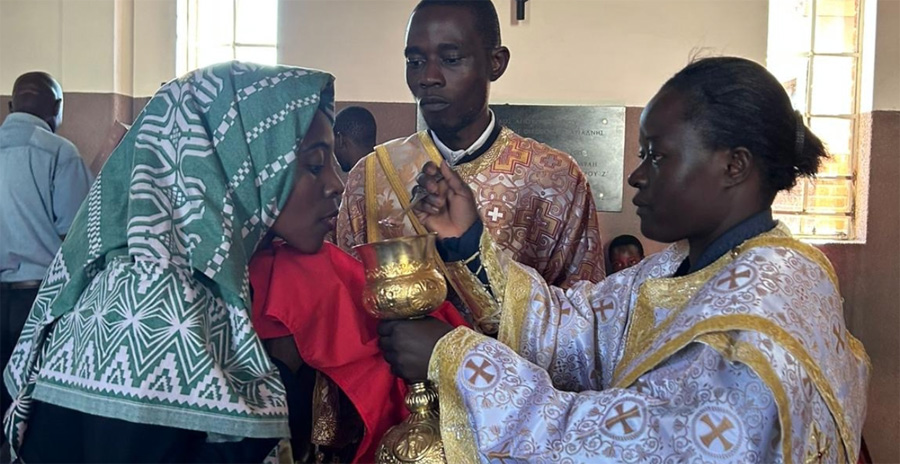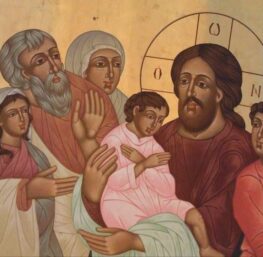 by Fr. Lawrence Farley –
by Fr. Lawrence Farley –
In the ongoing debate over the legitimacy of the new so-called “deaconesses” established by some Orthodox in Africa we often hear of “the slippery slope argument.” Some people use the term with approval, insisting that there does indeed exist a slippery slope from the new Order of deaconesses to that of women priests and bishops, while others speak of “the fallacy of the slippery slope argument”, affirming that there is no real connection between the new Order of deaconesses and the possibility of ordaining women priests and women bishops.
The slippery slope argument itself runs like this: as soon as the Orthodox Church allows vested females, whether female altar servers or women functioning like male deacons, sooner or later the Church will ordain women priests and bishops. That is, I suggest, because for the majority of the faithful the real obstacle to the ordination of women clergy is not Biblical or theological, but visual.
They have never seen girls or women functioning liturgically in the altar, and so the sight of women clergy is emotionally jarring for them, and they therefore conclude that such ordinations are wrong. But as soon as the sight of vested females functioning in the altar becomes commonplace, the sight will no longer be emotionally jarring, and the resistance to the ordination of women to all Church offices will disappear.
Many scholars rightly point out that there is no real theological connection between serving as an altar server and ordination to the priesthood and episcopate. That is true. But it is also irrelevant, because the laity are not moved by the theological considerations that move scholars. By “Holy Tradition” many of the laity mean simply a combination of what their grandmothers told them and what they see and experience in the church services. When the latter changes, the laity as a whole will accept the change because they are moved by familiarity, not by the teaching of the Bible or the Fathers. There are exceptions, of course, but this is broadly and universally true. That is why the slope is slippery: visual familiarity with vested females functioning in the altar will eventually bring with it acceptance of vested females functioning as priests, and then bishops.
The truth of this assertion should not need debating, for the connection between female servers and female bishops has already been demonstrated in the West time and time again. We do not need a crystal ball to examine the future, just a history book to document the past. Or, in the case of aged dinosaurs like myself, a good memory.
The churches of the magisterial Reformation and its daughters—that is, the Anglican/ Episcopal churches, the Methodist churches, the Presbyterian churches, the United churches—all uniformly traveled down this road. Take, for example, the Anglican churches, the ones I know best because of my own involvement there. It all began with allowing girls to serve as altar servers. If we could have altar boys, why not altar girls? No one at that time was thereby arguing for women priests or women bishops, and it was solemnly intoned that the introduction of female servers (called by some wags “serviettes”) had nothing to do with the completely different question of women priests.
So, altar girls were introduced. Then came the introduction of deaconesses, first considered a different Order from that of deacons and who did not serve in the altar (we had some scholars among us, after all), but quickly later declared to be exactly the same as deacons except for their gender. Then came the introduction of women priests.
The manner of the introduction is instructive: it did not begin with a worldwide Anglican synod of bishops considering the matter and agreeing that it could go forward, but by three retired bishops in a defiant and renegade act—not in Africa, as with us, but in Philadelphia in 1974. When no real canonical consequences resulted from the ordinations, other liberal bishops were emboldened, and soon the ordination of women became normative. I remember well the comment of one bishop about it: “There are Biblical reasons against it, but no theological ones.” You could almost hear Fathers like John Chrysostom spinning in their grave over the sundering of theology from Biblical truth.
Then, since women priests were common, women bishops followed in short order. Of course, throughout this whole process, there was protest—brave clergy and laity pointing out that the ordination of women was contrary to Scripture and the universal and immemorial practice of the Church. Letters were written, counter-letters were written, conferences held, etc. etc. etc. But the die was cast and the result inevitable: women clergy were here to stay. Please note the genesis of the whole thing: the introduction of vested females in the church services.
This pattern was more or less followed by all the other mainline Protestant churches—ordinations, protest, debate, all leading to the same result. The reason for the inevitability of the result will be discussed below. But we do not need to wonder if the current ordination of women “deacons” will lead to women priests and women bishops. We have already seen from many other churches that this is the predestined result.
The often-trumpeted triumphalistic notion that what happened everywhere in mainline Protestantism could never happen here in Orthodoxy is simply magical thinking. Are we that much holier than them? Smarter? Is it because we are “the true Church”? The “true Church” suffered dramatic losses in the fourth century when the Arian heresy ran rampant among us. If heresy could do such damage in the true Church in the fourth century, why could heresy not do like damage in the twenty-first century?
We see this too in the growth of such heresy among us even now. In the past people like Elizabeth Behr-Sigel, Eva Topping, Metropolitan Kallistos Ware, and Metropolitan Anthony Bloom have stated their support for such ordination. Today Carrie Frost has written that “we should welcome that conversation” about women priests and bishops, and Valerie Karras has said many times that she sees no theological reason why women may not be so ordained. Given such support, is there any doubt about the final goal of having women priests? It scarcely matters whether or not there is a theological connection between altar servers and priests. The final goal has already been set and agreed upon. It is disingenuous and dishonest to keep harping about there being a lack of connection when the goal has been made clear for anyone with eyes to see.
We turn now to the question of causality and why the move from vested females in the altar to women clergy is inevitable. The answer can be summed up in one word: liberalism (or “theological liberalism”, which admittedly is two words).
That is why the mainline Protestant churches pursued the path they did. Theological liberalism has been afflicting them for over a hundred and fifty years (Strauss’ Life of Jesus was published in 1835), questioning and denying everything from the existence of hell to the divinity of Christ, to the virgin birth to the historicity of Christ’s miracles and of His Resurrection. Having rejected the Tradition of the Church that they received at the Reformation and thereafter, they were at the mercy of whatever was culturally ascendant in their day.
Thus, when feminism became culturally ascendant in the 1960s, its dogmas were accepted by the mainline churches too. The move to ordain women clergy did not arise from a closer examination of the New Testament, but from capitulation to whatever was currently ascendant in the surrounding culture.
We see the same thing occurring among some Orthodox today where the Tradition of the Church is being rejected as authoritative. This does not mean that the Tradition is being rejected in toto, but only when it conflicts with secular dogmas, such as feminism.
For example, secular culture has no interest in the miracles of Christ, and so liberal Orthodox bowing down to secular culture can accept His miracles and still conform to secular culture. But our culture has a great interest indeed in saying that a woman can do any job that a man can do and so liberal Orthodox bowing down to secular culture reject the exclusion of women from the priesthood.
Note too that, though no doubt unintended by liberal Orthodox, the departure from Tradition will certainly not end with the ordination of women as clergy. The final departures will be much more radical (and abominable) than that. In some places the very difference between the genders is being erased.
Currently our culture not only insists that women can be priests, but also that two men can marry each other, that babies can be killed in utero, and that gender can be freely chosen. The liberal mainline churches are naturally falling in line, as are some Orthodox because their guiding principle is not Tradition, but the reigning norms of secular society. If you doubt this, check out the recent actions of Archbishop Elpidophoros and others like him.
It remains to inquire how Orthodoxy in the West came to this pass. I suggest that it comes from the eclipse of the Gospel in favour of ethnocentrism, the making central of one’s ethnic identity (which often includes a political component).
Here in the West this ethnocentrism is expressed by hyphenating one’s Orthodox identity: I am not just Orthodox, but Greek-Orthodox (a single word), or Russian-Orthodox, or Ukrainian-Orthodox. If asked the question, “Which is more important—the Gospel or ethnic identity?”, they will of course answer, “the Gospel”. But that is the point: the question is rarely allowed to be asked, for the two realities have become fused.
Often financial survival depends upon the fusion (and confusion) and upon never distinguishing the two. I remember once a priest from such an “ethnic jurisdiction” (please forgive the term) asked me how many members we had in our parish. I answered, “About 60”. He further asked, “And how many come to church on Sunday?” I was a bit puzzled, for I had already told him: “About 60”. For him, membership had little to do with Sunday attendance. His church had about 400 members—i.e. dues-paying members, but only a much smaller fraction actually came to Liturgy on Sunday. They were members not because they had responded to the Gospel and given their lives to Christ, but because they were members of the same ethnic group. For them the Church existed to preserve and express their ethnic identity.
The problem with this is that it becomes possible in such a situation to imagine that one is Orthodox simply because one is a Greek (or a Russian or a Ukrainian or a Serb) and not because one has given themselves to Christ. How does one convert someone who thinks he is already converted? Such people regard themselves as Orthodox Christians when in fact they are secular people of a particular ethnic group with a thin veneer of Orthodoxy painted over top. Their views on sexuality, abortion, and women clergy will be determined not by Orthodox teaching, but by whatever is culturally ascendant. If many in the Orthodox Church today would welcome women clergy, that is the real reason: the eclipse of the Gospel and the Tradition of the Church in certain areas and their replacement with the secular values of our day.
I hasten to add the obvious: not everyone in such ethnically-defined churches is like this, and there exist there many fine and dedicated people there for whom Christ is everything. I am speaking of a tendency and a problem that exists in some such places, and am not painting everyone there with the same brush.
What is needed for those afflicted by this tendency is conversion. It must be preached, taught, and insisted upon that what makes a person an Orthodox Christian is not adherence to a particular ethnic group with marginal church attendance, but a life completely given over to Christ and lived according to the Gospel and the apostolic Tradition, even if that Tradition flies in the face of our secular culture.
If a church group rejects the counter-cultural Gospel and the Church’s Tradition it will eventually wither and die (the fate now overtaking the liberal Protestant churches). And that demise would be a good thing. The eternal stakes are too high to offer a counterfeit and secularized Christianity.
Better for the souls of all to make crystal clear the choice between the truth and error, light and darkness. The path into the darkness truly is slippery. It is as the Lord said: “If the blind lead the blind, both will fall into a pit.”
—————————————————
HT: No Other Foundation. (Minor organizational edits and bolding of key phrases done by blog editors done to enhance readability.)




Isn’t liberal Orthodox an oxymoron?
Indeed it is. An overwhelming majority of liberal issues contradict the Orthodox Christian faith. Unfortunately, many clergy and faithful refuse to acknowledge this truth.
Taking a deep breath because my observations are decidedly “unorthodox”, but as a woman and a convert to Orthodoxy, I feel compelled to make them. Please feel free to delete if you consider them inappropriate. I can think of several instances in the Bible that support an all-male priesthood, such as God’s selection of Moses and Aaron, and the subsequent anointing of exclusively men to the priesthood (and please don’t give me that tired argument about “the standards of the times”. By the standards of those particular times, Judaism was a woman’s dream existence). Then there’s our Lord’s selection of all men as His Apostles. He had female followers, and treated them with considerable respect. But He still chose men to carry His Gospel to all the nations.
However, what seals the deal on the all-male priesthood is that – in Scripture, as well as in real life, it is the men who go out and seek God, and the women who stay home and care for the household and the family. And in every instance where God interacts with women, *He comes to them*. It is women who have been entrusted to bear and nurture children, God’s future for mankind. Bluntly put, God is already in our lives as women. But men tend to think they can Do It All themselves; they forget that they need God. So God has given them the gift of the priesthood so that they may learn how much they need Him. The priesthood is God’s way of helping men catch up to the native spirituality of women.
So, ladies, stop getting in God’s way. He has enough of an uphill battle as it is.